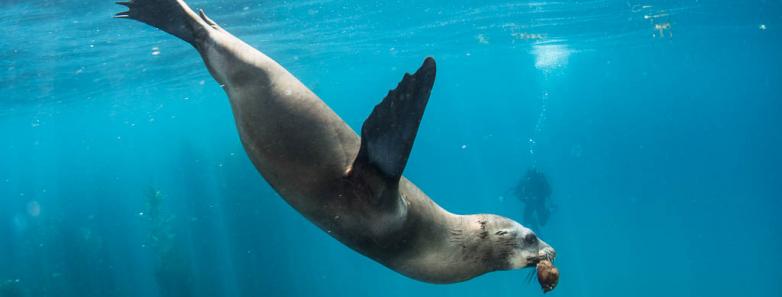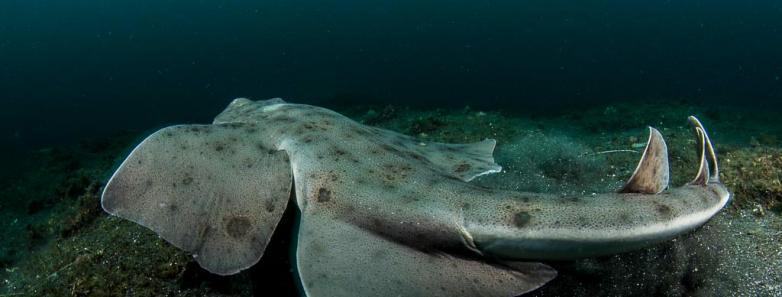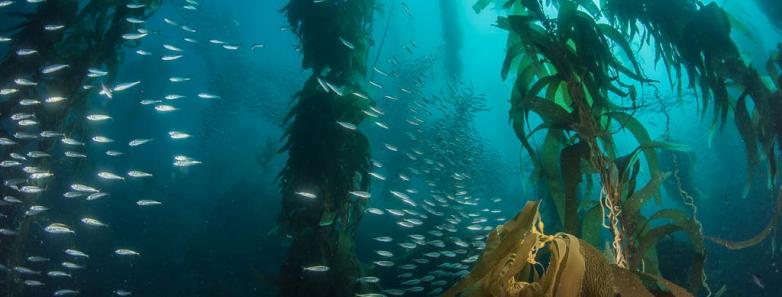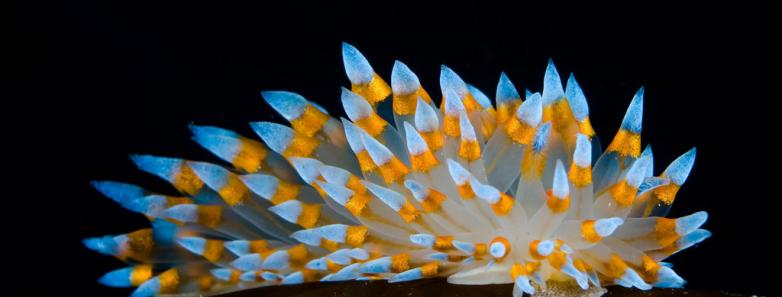SCUBA DIVING IN SOUTHERN CALIFORNIA
SOUTHERN CALIFORNIA HIGHLIGHTS
Diving in Southern California can be a surprisingly rich experience offering a lot of diversity in marine life and leading you through its majestic kelp forests. Besides being a beautiful place to enjoy some gorgeous sunsets, the coastline of California features many exciting destinations for scuba divers. Marine life enthusiasts and underwater photographers can see seals, large schools of fish and nudibranchs, just to name a few. You can even meet dolphins or humpback whales!
JUMP TO:
Marine Life - Best Dive Sites - Conditions and Difficulty Level
How to Get There - Practical Information
INTRODUCTION TO DIVING IN SOUTHERN CALIFORNIA
Nutrient-rich Pacific waters boast exquisite marine life diversity and natural features, attracting underwater photographers from across the globe, particularly to explore the Channel Islands, ranging from 15-50 miles off the mainland. The most popular islands for diving are Catalina, San Clemente, Santa Barbara, Anacapa, Santa Cruz, and San Miguel.
Except for Catalina Island, the only way to dive the Channel Islands is via boat. Most divers choose 1 or 2-day trips, doing 3-4 dives per day. Vessels out of Ventura and Santa Barbara travel to Anacapa, Santa Cruz, Santa Rosa, and San Miguel Islands, while boats out of San Pedro and Long Beach visit Catalina, San Clemente, and Santa Barbara Islands. Boats out of Santa Barbara or Ventura will sometimes also visit these destinations on 2-3 day trips.
Additionally, Southern California boasts over 50 State and Federal Marine Protected Areas, from Point Conception to the Mexican border. Some of these Underwater Parks were established as recently as 2012, and already the ecosystems within are reflective of the protection, naturally thriving. Altogether, the state of California boasts over 100 Marine Protected Areas.
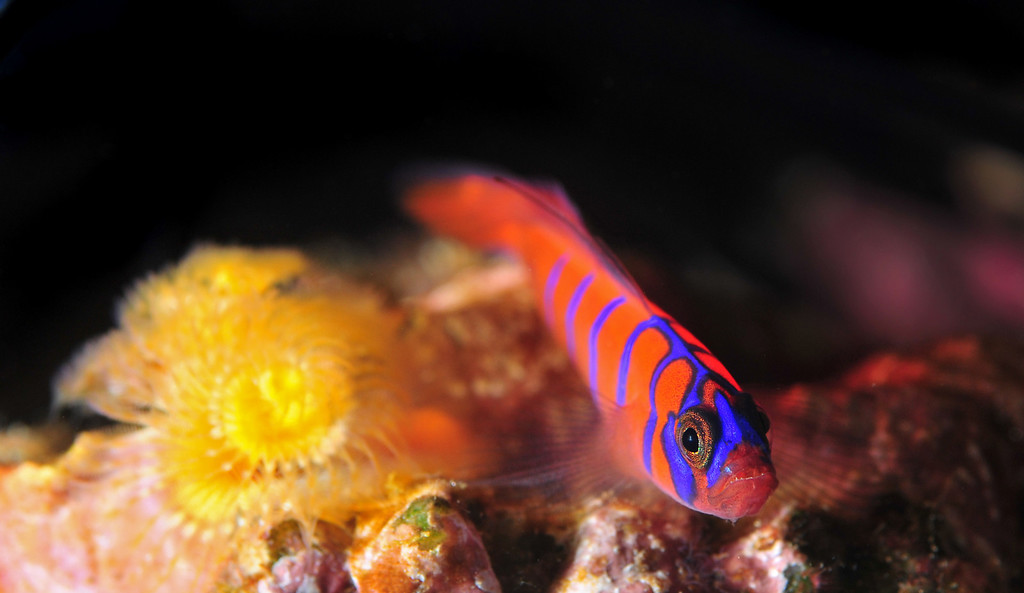
WHEN TO GO
There is something to see all year round in Southern California, but when you are especially interested in big fish like whales, then you must pay closer attention to their migrating pattern. The best season to see bigger animals starts from spring through late fall. Except gray whales tend to pass through from mid-December to mid- April.
HOW TO DIVE SOUTHERN CALIFORNIA
Scuba Diving in Southern California can be done via shore or by boat. Boats leave out of Mission Bay in San Diego, Long Beach, San Pedro, Oxnard or Santa Barbara - and boat diving generally offers much better conditions underwater than shore diving.
One-day trips visit Anacapa Island, Catalina Island, the Oil Rigs, or the San Diego kelp forests. Multi-day liveaboard trips will visit the outer island like Santa Barbara or San Clemente Islands.
CALIFORNIA MARINE LIFE
The underwater life in California is one of the richest in the world having thousands of species of fish to see. You have dive sites for macro lovers where many invertebrates live and you can see a variety of reef fish. During the night time, different crustaceans like crabs and shrimps like to come out, and squid spawning events offer an incredible night diving experience. Sea mammals, like seals and sea otters, sometimes like to pose in front of your camera. Not just underwater, but even from the boat, you can find yourself surrounded by playful dolphins. And the biggest sea mammals like the killer, humpback and gray whales are not missing from the list either. Diving in California might not be the first scuba destination that comes to mind when thinking about colorful marine life, but it definitely will not disappoint.
List of some of the marine life you can see when diving in California:
- Harbor Seal
- California Sea Lions
- Dolphins
- Humpback Whales
- Wolf Eel
- Giant Black Sea Bass
- Large Schools of Fish
- Pacific Seahorse
- Torpedo Rays
- Angel Shark
- Leopard Shark
- Nudibranchs
- Different Molluscs
- Different Crustaceans
- Sponges and anemones
DIVING CONDITIONS AND DIFFICULTY
Conditions for scuba diving in Southern California are good all year round. The best time to dive is during fall when visibility is the best as it is not as windy as during spring. The average water temperatures go up to 68 F (20 C ) during the summer and during the winter staying between 57 to 59 F ( 14 to 15 C ).
The destination offers dive sites for all levels. There are some sites more suitable for experienced divers with stronger current and deeper depths but you can also find other shallower sites for beginner divers.
BEST DIVE SITES IN SOUTHERN CALIFORNIA
Based on our travel experts' knowledge of the area, we have picked out some of the best dive sites to visit in Southern California.
La Jolla Cove - Most of Southern California's best dive sites are from the boat but if you prefer shore dives, then this is the spot to go for. This shore dive gives you all the best parts of diving in California- the kelp forests and almost all the marine life in California.
Oil Rigs of Orange County - Attractive to all types of divers and one of the easiest wall dive you can do. A unique dive where man-made rigs have turned into huge colorful reefs rich with marine life. You can see sea lions, rockfish, garibaldi, sheepshead, opaleye and a lot of other fish.
Casino Point, Catalina Island - Dive site that shows you a little bit of everything, including even two deep wrecks! The place to dive through the magical kelp forest, sand planks, pinnacles and rich in marine life. Here you can meet octopus, moray eels, giant kelpfish, and bat rays. All the reasons why we cannot leave it out of our top picks.
Farnsworth Banks, Catalina Island - Best dive site for experienced divers. Covered with California purple hydrocoral, filled with fish and the divers can go between huge underwater mountains. Sounds great, doesn't it? You can see torpedo rays, scorpionfish, moray eels, shrimp, crabs, and many reef fish.
Sea Lion Rookery, Santa Barbara Island - As you can guess from the name, it is a great place for close encounters with sea lions. Sometimes you can even swim with a big group of them! The dives are in shallow clear water.
Coral Reef, Anacapa Island - Great place for macro and wide-angle photography fans and one of the favorite places for brittle stars, which you can spot plenty. Be aware that the current can sometimes be strong at Coral Reef.
Wyckoff Ledge, San Miguel - Love nudibranchs? Then this is the spot, plus you can see some wolf eels and rare Mosshead Warbonnets. It is also a great wall dive offering options for both, deep and shallow dives.
CALIFORNIA TRAVEL INFORMATION
HOW TO GET TO SOUTHERN CALIFORNIA
The main airport in Southern California is Los Angeles International (LAX), which also covers a lot of domestic travel. Another city near great diving, San Diego, has San Diego Airport which has both international and domestic flights. You will need a car to get to the various boat docks.
TOPSIDE ACTIVITES
Besides visiting us in our Culver City location, there are various things to do in Southern California! If you are out on the islands, take a day and explore Catalina Island, take a nice scenic walk, or just grab some lunch at one of the fine restaurants on the island. If you are land-based, take a bike ride along "the strand" through Santa Monica and Venice beaches. Take a hike to the Hollywood sign and view the surrounding mountains along the Runyon Canyon trail. Or go explore Hollywood Boulevard and Universal Studios Hollywood Theme Park.
PRACTICAL INFORMATION
- Currency: US Dollar
- Language: English
- Main Airport Code: LAX
- Time Zone: UTC-8
- Electricity: 120 V 60 Hz
Interested in going diving in Southern California? Contact us for booking or more information.

